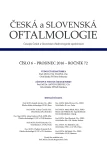Difficult Diagnosis of Non-strabismic Binocular and Accommodative Disorders
Authors:
P. Kříž
Authors‘ workplace:
Biofyzikální ústav Lékařské fakulty MU, Brno, přednosta prof. RNDr. Vojtěch Mornstein, CSc.
Published in:
Čes. a slov. Oftal., 72, 2016, No. 6, p. 216-222
Category:
Original Article
Overview
The aim of the paper is to inform about the current approach to the diagnosis of non-strabismic binocular and accommodative disorders. A large number of studies quote high occurrence of them in both clinical and nonclinical populations. They also point out the presence of a diagnosis deficiency or insufficient diagnosis within the optometric and ophthalmological practice. The representation in population depends not only on race and age, but also on the methodology of diagnostic tests, and the chosen diagnostic criteria in particular. For the purpose of division of binocular and accommodative disorders there are several classification systems. The widespread classification facilitates a better understanding of a great spectrum of symptoms, assignment of the characteristic signs, and decision about appropriateness and choice of treatment types.
Key words:
heteroforie, binocular disorders, accommodative disorders, fusional vergence, convergence insufficiency, convergence excess
Sources
1. Borsting, E., Rouse, M.W., Hovett, S. et al.: Association of symptoms and convergence and accommodative insufficiency in school-age children. Optometry, 74(1); 2003: 25–34.
2. Burian, H.M., Noorden, G.K.: Binocular Vision and Ocular Motility: Theory and Management of Strabismus. 6th edition. St. Louis, Mo: Elsevier LTD, Oxford; 2001, 653 s.
3. Ciuffreda, K.J.: The scientific basis for and efficacy of optometric vision therapy in nonstrabismic accommodative and vergence disorders. Optometry, 73(12); 2002: 735–62.
4. Daum, K.M.: Accommodative dysfunction. Doc Ophthalmol, 55(3); 1983: 177–98.
5. Dusek, W., Pierscionek, B.K., McClelland, J.F.: A survey of visual function in an Austrian population of school-age children with reading and writing difficulties. BMC Ophthalmol, 10(1); 2010: 16–16.
6. Dwyer, P., Wick, B.: The influence of refractive correction upon disorders of vergence and accommodation. Optom Vis Sci, 72(4); 1995: 224–32.
7. Evans, B.J.W.: Pickwell’s Binocular Vision Anomalies. 5th Revised edition. Edinburgh; New York: Elsevier Ltd, Oxford; 2007, 454 s.
8. Gall, R., Wick, B.: The symptomatic patient with normal phorias at distance and near: What tests detect a binocular vision problem? Optometry, 74(5); 2003: 309–22.
9. Godts, D., Tassignon, M-J., Gobin L.: Binocular vision impairment after refractive surgery. J Cataract Refract Surg, 30(1); 2004: 101–9.
10. Hoffman, L.G.: Incidence of vision difficulties in children with learning disabilities. J Am Optom Assoc, 51(5); 1980: 447–51.
11. Hokoda, S.C.: General binocular dysfunctions in an urban optometry clinic. J Am Optom Assoc, 56(7); 1985: 560–2.
12. Jeffrey, S., Cooper, M.S., Burns, R.C. et al.: Optometric clinical practice guideline care of the patient with accommodative and vergence dysfunction. St Louis Am Optom Assoc, 2010.
13. Kříž, P.: Fúzní rezervy: nepřímé měření. Čes Oční Opt, 57(3); 2016: 16–9.
14. Lara, F., Cacho, P., García, A. et al.: General binocular disorders: prevalence in a clinic population. Ophthalmic Physiol Opt J Br Coll Ophthalmic Opt Optom, 21(1); 2001: 70–4.
15. Matsuo, T., Ohtsuki, H.: Follow-up results of a combination of accommodation and convergence insufficiency in school-age children and adolescents. Graefes Arch Clin Exp Ophthalmol, 230(2); 1992: 166–70.
16. Palomo Alvarez, C., Puell, M.C., Sánchez-Ramos C. et al.: Normal values of distance heterophoria and fusional vergence ranges and effects of age. Graefes Arch Clin Exp Ophthalmol, 244(7); 2006: 821–4.
17. Porcar, E., Martinez-Palomera, A.: Prevalence of general binocular dysfunctions in a population of university students. Optom Vis Sci, 74(2); 1997: 111–3.
18. Razavi, M.E., Poor, S.S.H., Daneshyar A.: Normative values for the fusional amplitudes and the prevalence of heterophoria in adults. Iran J Ophthalmol, 22(3); 2010: 41–6.
19. Rouse, M.W., Hyman, L., Hussein M. et al.: Frequency of convergence insufficiency in optometry clinic settings. Optom Vis Sci, 75(2); 1998: 88–96.
20. Russell, G.E., Wick, B.: A prospective study of treatment of accommodative insufficiency. Optom Vis Sci, 70(2); 1993: 131–5.
21. Shin, H.S., Park, C.M., Park, S.C.: Relationship between accommodative and vergence dysfunctions and academic achievement for primary school children. Ophthalmic Physiol Opt, 29(6); 2009: 615–24.
22. Scheiman, M., Gallaway, M., Ciner E.: Prevalence of visual anomalies and ocular pathologies in a clinic pediatric population. J Am Optom Assoc, 67(4); 1996: 193–201.
23. Scheiman, M., Wick, B.: Clinical Management of Binocular Vision: Heterophoric, Accommodative, and Eye Movement Disorders. 4th edition. Lippincott Williams&Wilki; 2013, 722 s.
24. Vaughn, W., Maples, W.C., Hoenes R.: The association between vision quality of life and academics as measured by the College of Optometrists in Vision Development Quality of Life questionnaire. Optom - J Am Optom Assoc, 77; 2006: 116–23.
25. Wajuihian, S.O., Hansraj, R.: A review of non-strabismic accommodative-vergence anomalies in school-age children. Part 1: Vergence anomalies. Afr Vis Eye Health, 74(1); 2015: 10 s.
26. Wajuihian, S.O., Hansraj, R.: A review of non-strabismic accommodative and vergence anomalies in school-age children. Part 2: Accommodative anomalies. Afr Vis Eye Health, 74(1); 2015: 7 s.
27. Wajuihian, S.O., Hansraj, R.: Vergence anomalies in a sample of high school students in South Africa. J Optom, 2015: 12 s.
28. Worrell, Jr. B.E., Hirsch, M.J., Morgan, M.W.: An evaluation of prism prescribed by Sheard’s criterion. Am J Optom Arch Am Acad Optom, 48(5); 1971: 373–6.
Labels
OphthalmologyArticle was published in
Czech and Slovak Ophthalmology

2016 Issue 6
Most read in this issue
- Central Serous Chorioretinopathy as a Masquerading Syndrome of Choroidal Hemangioma
- Difficult Diagnosis of Non-strabismic Binocular and Accommodative Disorders
- AMNIOTIC MEMBRANE APPLICATIONS – OUR EXPERIENCE
- Disorders of Simple Binocular Vision in Heterophoria and their Spectacle Correction
